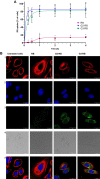Triazine-Carbosilane Dendrimersomes Enhance Cellular Uptake and Phototoxic Activity of Rose Bengal in Basal Cell Skin Carcinoma Cells
- PMID: 35321027
- PMCID: PMC8935628
- DOI: 10.2147/IJN.S352349
Triazine-Carbosilane Dendrimersomes Enhance Cellular Uptake and Phototoxic Activity of Rose Bengal in Basal Cell Skin Carcinoma Cells
Abstract
Background: The search for new formulations for photodynamic therapy is intended to improve the outcome of skin cancer treatment using significantly reduced doses of photosensitizer, thereby avoiding side effects. The incorporation of photosensitizers into nanoassemblies is a versatile way to increase the efficiency and specificity of drug delivery into target cells. Herein, we report the loading of rose bengal into vesicle-like constructs of amphiphilic triazine-carbosilane dendrons (dendrimersomes) as well as biophysical and in vitro characterization of this novel nanosystem.
Methods: Using established protocol and analytical and spectroscopy techniques we were able to synthesized dendrons with strictly designed properties. Engaging biophysical methods (hydrodynamic diameter and zeta potential measurements, analysis of spectral properties, transmission electron microscopy) we confirmed assembling of our nanosystem. A set of in vitro techniques was used for determination ROS generation, (ABDA and H2DCFDA probes), cell viability (MTT assay) and cellular uptake (flow cytometry and confocal microscopy).
Results: Encapsulation of rose bengal inside dendrimersomes enhances cellular uptake, intracellular ROS production and concequently, the phototoxicity of this photosensitizer.
Conclusion: Triazine-carbosilane dendrimersomes show high capacity as drug carriers for anticancer photodynamic therapy.
Keywords: amphiphiles; carbosilane; dendrimersomes; dendrons; photodynamic therapy; rose bengal.
© 2022 Sztandera et al.
Conflict of interest statement
The authors report no conflicts of interest in this work.
Figures









Similar articles
-
Molecular interactions driving the complexation of rose bengal by triazine-carbosilane dendrons.Nanoscale. 2025 Jan 16;17(3):1433-1448. doi: 10.1039/d4nr02335h. Nanoscale. 2025. PMID: 39620325
-
pH-Sensitive Dendrimersomes of Hybrid Triazine-Carbosilane Dendritic Amphiphiles-Smart Vehicles for Drug Delivery.Nanomaterials (Basel). 2020 Sep 23;10(10):1899. doi: 10.3390/nano10101899. Nanomaterials (Basel). 2020. PMID: 32977594 Free PMC article.
-
Cationic Phosphorus Dendrimer Enhances Photodynamic Activity of Rose Bengal against Basal Cell Carcinoma Cell Lines.Mol Pharm. 2017 May 1;14(5):1821-1830. doi: 10.1021/acs.molpharmaceut.7b00108. Epub 2017 Apr 6. Mol Pharm. 2017. PMID: 28350966
-
In Search of a Phosphorus Dendrimer-Based Carrier of Rose Bengal: Tyramine Linker Limits Fluorescent and Phototoxic Properties of a Photosensitizer.Int J Mol Sci. 2020 Jun 23;21(12):4456. doi: 10.3390/ijms21124456. Int J Mol Sci. 2020. PMID: 32585884 Free PMC article.
-
pH-stable polymersome as nanocarrier for post-loaded rose bengal in photodynamic therapy.Colloids Surf B Biointerfaces. 2022 Sep;217:112662. doi: 10.1016/j.colsurfb.2022.112662. Epub 2022 Jun 27. Colloids Surf B Biointerfaces. 2022. PMID: 35785717
Cited by
-
Antimicrobial peptide-targeted photodynamic therapy for preventing periodontal plaque biofilm formation through the disruption of quorum sensing system.Mater Today Bio. 2025 Jun 18;33:101970. doi: 10.1016/j.mtbio.2025.101970. eCollection 2025 Aug. Mater Today Bio. 2025. PMID: 40677408 Free PMC article.
-
Dendrimer-Mediated Delivery of DNA and RNA Vaccines.Pharmaceutics. 2023 Mar 30;15(4):1106. doi: 10.3390/pharmaceutics15041106. Pharmaceutics. 2023. PMID: 37111593 Free PMC article. Review.
-
The Spicy Science of Dendrimers in the Realm of Cancer Nanomedicine: A Report from the COST Action CA17140 Nano2Clinic.Pharmaceutics. 2023 Jul 24;15(7):2013. doi: 10.3390/pharmaceutics15072013. Pharmaceutics. 2023. PMID: 37514199 Free PMC article. Review.
-
Adaptive Synthesis, Supramolecular Behavior, and Biological Properties of Amphiphilic Carbosilane-Phosphonium Dendrons with Tunable Structure.Biomacromolecules. 2024 Dec 9;25(12):7799-7813. doi: 10.1021/acs.biomac.4c01092. Epub 2024 Nov 11. Biomacromolecules. 2024. PMID: 39526947 Free PMC article.
-
Unveiling the potential of photodynamic therapy with nanocarriers as a compelling therapeutic approach for skin cancer treatment: current explorations and insights.RSC Adv. 2024 Jul 10;14(30):21915-21937. doi: 10.1039/d4ra02564d. eCollection 2024 Jul 5. RSC Adv. 2024. PMID: 38989245 Free PMC article. Review.
References
MeSH terms
Substances
LinkOut - more resources
Full Text Sources

